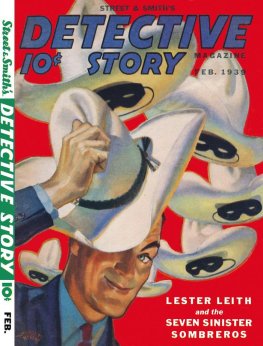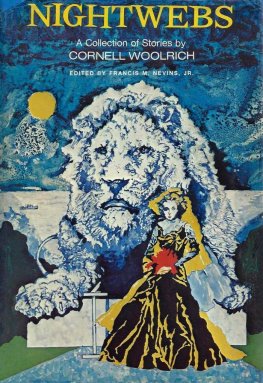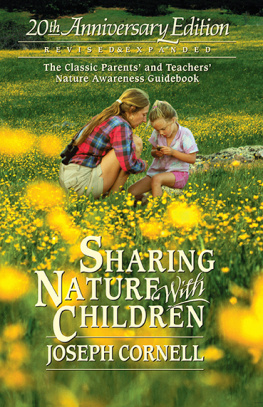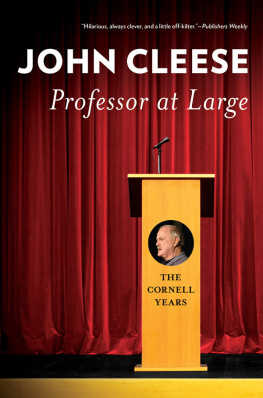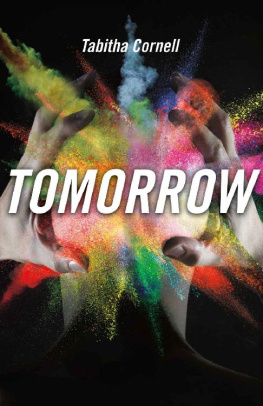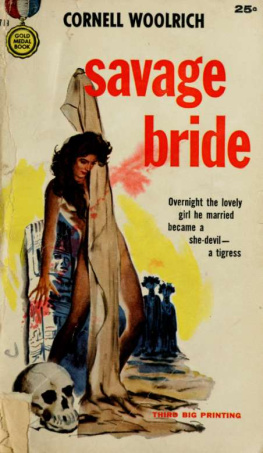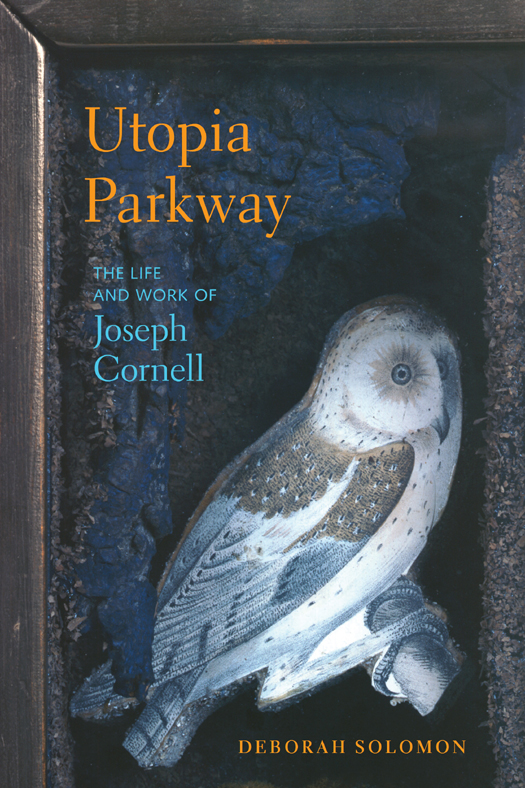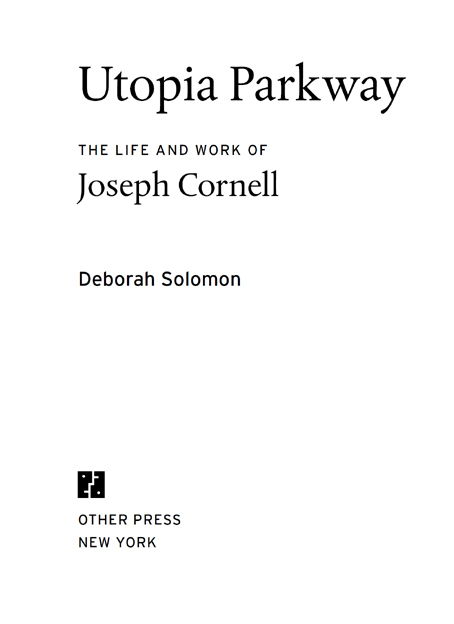PRAISE FOR UTOPIA PARKWAY
Masterly a meticulously researched and deeply considered examination of how Cornells daily life contributed to his imaginative life the only real life he knew. Deborah Solomon brings to [Cornells] life a lucid intelligence, an incisive knowledge of art history, and a rare sensibility. Her generous understanding illuminates Cornell as a knight errant of art.
ANNE TRUITT, WASHINGTON POST
With literary flair and shrewd interpretation, Deborah Solomon supplies the drama that Cornells life outwardly lacked.
KENNETH BAKER, SAN FRANCISCO CHRONICLE BOOK REVIEW
His life of quiet deliberation has found an exceptionally apt biographer in Deborah Solomon, whose graceful prose well suits the master collagist whose boxed congeries illuminated the kinetic poetry of ordinary things.
ALBERT MOBILIO, VOICE LITERARY SUPPLEMENT
Joseph Cornells art juxtaposed the most ordinary objects, and transformed them into magical presences by placing them in boxes. Deborah Solomons clear-eyed and sympathetic narrative does for his life what he, as an artist, did for his penny world. Her book models itself upon its subject and, without sensational revelation or arcane theory, displays it as something rare. It is the book about Cornell I would not dare to have hoped for in our mean and deconstructionist age.
ARTHUR C. DANTO, SLATE
Fascinating reading Skillfully weaving together fact, anecdote, and conjecture, Solomon brings Cornells place in the art world and his legacy to artists of the younger generation into sharp focus.
ALLISON KEMMERER, BOSTON BOOK REVIEW
Joseph Cornell loved ballet and ballerinas; he was a friend and I thought I knew him well. But only in Deborah Solomons poignant book did I discover the complexity of his inner life and the extent of his creative powers.
ALLEGRA KENT, FORMER PRINCIPAL DANCER, NEW YORK CITY BALLET
As perfectly composed, richly nuanced, and quietly surprising as one of Cornells boxes.
DONNA SEAMAN, CHICAGO TRIBUNE
ALSO BY DEBORAH SOLOMON
American Mirror: The Life and Art of Norman Rockwell
Jackson Pollock: A Biography
Copyright 1997 by Deborah Solomon
First published by Farrar, Straus and Giroux, in 1997
Preface to the 2015 edition 2015 by Deborah Solomon
Photographs of works by Joseph Cornell
the Joseph and Robert Cornell Memorial Foundation
Photographs by Hans Namuth Hans Namuth
Photographs by Harry Roseman Harry Roseman
Cover: Joseph Cornell, Untitled (Owl Box) [detail], c. 1948
Frontispiece: Joseph Cornell reading in his back yard
(photograph by Harry Roseman)
Production editor: Yvonne E. Crdenas
All rights reserved. No part of this publication may be reproduced or transmitted in any form or by any means, electronic or mechanical, including photocopying, recording, or by any information storage and retrieval system, without written permission from Other Press LLC, except in the case of brief quotations in reviews for inclusion in a magazine, newspaper, or broadcast. For information write to Other Press LLC, 2 Park Avenue, 24th Floor, New York, NY 10016. Or visit our Web site: www.otherpress.com
The Library of Congress has cataloged the printed edition as follows: Solomon, Deborah, author.
Utopia Parkway : the life and work of Joseph Cornell / Deborah Solomon.
pages cm
Includes bibliographical references.
ISBN 978-1-59051-714-7 (paperback)
ISBN 978-1-59051-715-4 (ebook)
1. Cornell, Joseph. 2. Artists United States Biography.
I. Title.
N 6537. C 66 S 64 2015
709.2 dc23
[ B ]
2015028854
v3.1
For Kent Sepkowitz
CONTENTS
ILLUSTRATIONS
Cornell reading in his yard at Utopia Parkway, 1971
The Cornell family at Coney Island, c. 1908
The Cornell family residence in Nyack, c. 1915
Joseph and Robert Cornell in Nyack, c. 1915
Cornell and his father in Maine, 1916
Cornell and his mother
Phillips Academy yearbook photograph of Cornell, 1921
Cornell with his sister Betty and his mother, c. 1928
The house on Utopia Parkway, 1930
Julien Levy
Untitled (Schooner), 1931
Untitled paperboard box, c. 1935
Untitled (Glass Bell), c. 1932
Announcement for Surrealisme exhibition, 1932
Untitled (Portrait of Lee Miller), c. 194849
Soap Bubble Set, 1936
A scene from Rose Hobart
Cornell contemplating Garbo: The Crystal Mask, c. 193940
Taglionis Jewel Casket, 1940
LEgypte de Mlle Clo de Mrode: Cours Elementaire dHistoire Naturelle, 1940
Untitled (Swan Box), c. 1945
Enchanted Wanderer: Excerpt from a Journey Album for Hedy Lamarr, 1941
Cornells workshop, 1970
Cornells workshop, 1971
Medici Slot Machine, 1942
Setting for a Fairy Tale, 1942
Ballet (for Jacques Offenbach), 1942
Untitled (Pharmacy), c. 1942
Detail of The Crystal Cage (Portrait of Berenice), 1943
Cornells letter to Tilly Losch
Announcement for the Romantic Museum exhibition, 1946
Object 1941, 1941
Napoleonic Cockatoo, 1949
The Aviary exhibition, 1949
Untitled (Hotel de LEtoile: Night Skies, Auriga), 1954
The dwarf in the film Aviary
Untitled (Andromeda Hotel), c. 195354
A scene from Nymphlight
Untitled, c. 195659
A Parrot for Juan Gris, Winter 195354
Where Does the Sun Go at Night?, c. 1964
Untitled (Blue Nude), c. mid-1960s
The Heart on the Sleeve, 1972
Untitled (Time Transfixed), c. 1966
Announcement for the Robert Cornell memorial exhibition, 1966
The Uncertainty Principle, 1966
Laundry Boys Change, c. 1964
Cornell with Leila Hadley, 1971
Cornells garden, 1972
Cornells bedroom, 1972
Cornells dresser, 1972
Cornell with Yayoi Kusama, 1972
COLOR INSERT
A Dressing Room for Gilles, 1939
Rose Castle, 1945
Untitled (Bb Marie), early 1940s
Medici Slot Machine, 1946
Untitled (Penny Arcade Portrait of Lauren Bacall), 1946
Untitled (Owl Box), c. 1948
Untitled (Aviary with Parrot and Drawers), 1949
Penny Arcade (re-autumnal), 1964
PREFACE TO THE 2015 EDITION
This book was first published in 1997. In the years since, Joseph Cornell has been the subject of a steady profusion of tributes at galleries and museums. His work has even surfaced in, of all places, the hit television comedy The Simpsons. In an episode aired in 2009, Homer Simpsons ebullient eight-year-old daughter, Lisa, visits a museum and pauses in admiration before five enchanting Cornell boxes hanging on a wall.
Its a nifty homage but theres a slight error. The museum that Lisa Simpson visits is called the Springfield Museum of Folk Art, emphasis on folk, and Cornells boxes are displayed among patchwork quilts, oval Shaker boxes made from cherrywood, and other objects that evoke the agrarian ways of Americas past. But Cornell was not a folk artist. And the museums that own his work and keep it on permanent display, such as the Museum of Modern Art in New York, or the Art Institute of Chicago, are by no means folk art museums. The label folk art refers to artists who lack formal training and operate outside of an elite tradition. Cornell, by contrast, was very much a part of the New York art world. He began making art in the context of French Surrealism, exhibited his work at leading American galleries and art museums, and in spite of his extreme reticence befriended avant-garde figures ranging from Salvador Dal in the forties, to Willem de Kooning in the fifties, to Yayoi Kusama and Yoko Ono in the sixties.


